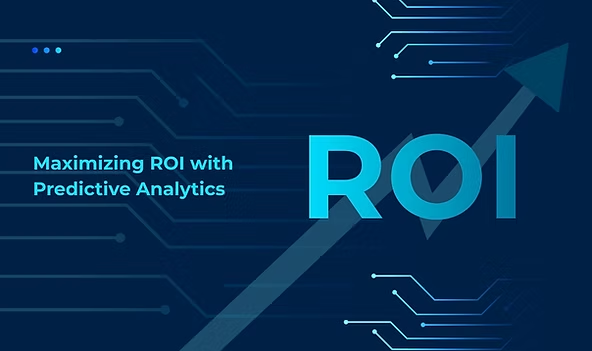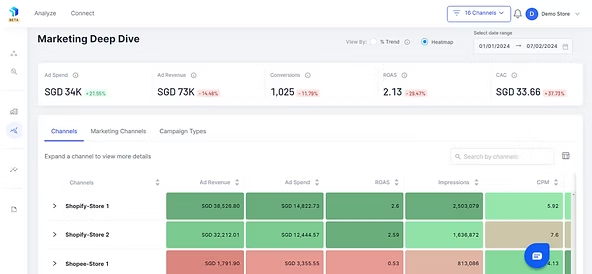
The eCommerce ecosystem is always changing.
There is increasing competition every single day, there are rapid changes in what consumers want, and there is an equally fast rate of change in what is on the market.
It is essential to have the right resources so that the brand can make quick, smart decisions.
This is where marketing predictive analytics comes in handy.
Predictive analytics in marketing implements artificial intelligence (AI) and machine learning (ML) to predict the tendencies or behaviors of customers in the future.
It uses historical data and analyzes the patterns for informed decision-making and planning. This helps marketing professionals predict requirements, increase campaign efficiency, and invest resources sensibly.
Businesses can therefore project outcomes including churn, lifetime value, and product demand using machine learning models.
Take this into account.
Inventory is one aspect of the business that is important for a company’s successful operation which can be enhanced through predictive analytics. The AI uses previous sales information, seasonal patterns, and industry standards to project the number of units for an item.
This can help you stock the most popular items at certain seasons before the demand goes overboard, reducing revenue loss and helping customer satisfaction.
Imagine you run a beauty store. Predictive analytics can transform your online retail operations by analyzing past data to forecast future trends:
This is just the tip of the iceberg, really.
There’s so much more data, that marketers can unravel through AI-driven marketing to boost their ROI. Let’s take a look at a few in detail.
Predictive analytics lets marketing managers know which customer segments will bring the most return on investment.
After understanding the purchase patterns, the buying interest, and people’s characteristics, AI models can make predictions of the customers who will result in the best lifetime value. This way, managers can use resources to target retention and upselling on the most profitable segments.
For instance, for an online retailer, predictive analytics can help in knowing which customers will self-serve and buy full-price items at the launch of the new collection. The marketing team can then create exclusive previews and early-access promotions for this group.
This focused strategy not only boosts revenues but also helps build customer loyalty among the most valuable segments which in turn translates into higher profits in the long run.
With predictive analytics, marketing managers can tailor messages to individual customers at scale.
AI tools can estimate what content, what offers, and what products will be more appealing to a certain user based on their preferences, what they browse, or what they have purchased. The result of such personalization is a more responsive audience, a better conversion rate, and increased customer happiness.
For instance, an eCommerce beauty brand could use predictive analytics to send emails with a new range of organic skincare products to those customers who frequently purchase natural cosmetics.
The system can also include the ability to decide when these emails can be sent based on the historical interaction levels of each customer. This level of personalization significantly boosts click-through and conversion rates, as customers receive relevant offers at the right time.
Predictive models can identify customers at risk of churning before they actually leave. With AI, when marketing managers observe some indicators like a drop in customer engagement or purchase frequency and even negative feedback from customers, these managers can implement retention strategies. This method cuts down on customer attrition rates and consequently boosts revenue retention.
An online subscription box service could use churn prediction to identify customers who have the highest probability of canceling their subscriptions.
For instance, the system may highlight customers who have delayed or missed delivery for several times or have not opened promotional emails. The marketing team can then send these at-risk customers personalized offers, such as a discount on their next box or the option to customize their product selection.
This way the company can control the potential churn, which eventually increases retention rates, maintains a good customer base, and strengthens it.
Predictive analytics can be a game changer for eCommerce businesses as it helps increase the return on investment (ROI). Companies can allocate resources toward the most rewarding opportunities with the help of advanced AI and ML models.
Predictive analytics have helped eCommerce to synthesize big data into executable strategies that reallocate resources better.
For instance, let’s say you are running several promotional campaigns through Meta and Google Ads for the same product. Instead of just randomly splitting the money into two-channels, predictive analysis can be used to determine what ROI is likely to be for each campaign.
The predictive models for ads, customer engagement, and conversions, in this case, take historical data into account to help determine which ad platform is likely to make the most money.
Predictive models are powerful tools for marketers, enabling data-driven decision-making that minimizes risk and maximizes opportunities.
These models forecast demand changes across regions and customer segments, allowing you to optimize pricing strategies and inventory management.
If demand drops for a product, you can adjust pricing or stock levels to maintain sales and avoid losses from excess inventory.
Moreover, predictive analytics helps identify emerging trends and untapped opportunities, such as increased demand for specific products in certain areas. This insight allows you to swiftly adapt your marketing campaigns, product development, and fulfillment operations to capitalize on these trends.
By analyzing historical data, AI models can forecast future demand, consumer behavior, and campaign performance. For example, if the model predicts seasonal spikes in demand for certain products, you can proactively adjust your marketing strategy. This might involve:
Predictive analytics allows you to identify high-performing keywords, adjust bids dynamically, and predict which ad creatives will resonate most with specific audience segments.
You can forecast campaign performance across different channels, enabling smarter budget allocation. A/B testing becomes more efficient as you can predict winning ad variations before full deployment.
Anticipating seasonal trends helps you adjust messaging to match consumer intent at the right time. Furthermore, you can personalize ad content based on predicted customer preferences and behaviors.
Success in eCommerce depends heavily on understanding your customers on a deeper level. Today, brands use predictive analytics to find customer insights and make decisions around them for sustainable growth.
Graas funnels the eCommerce data into actionable strategies thereby assisting businesses maximize returns on their investments. Here’s how:
Graas collects data from various marketplaces, company websites, as well as advertising platforms and therefore covers all the operational metrics of the company.
Today's shoppers interact with brands across numerous channels before buying. Organizations must be able to track and investigate these paths in order to find out what contact points are most effective and at which stage of the process. Graas helps simplify this otherwise fragmented and complicated process.

Graas’ advanced machine learning algorithms identify and understand complex trends in the data. This helps accurately predict when a particular trend or customer action will occur.
This foresight gives you enough time to strategize and leverage the opportunity that’s about to come.
Effortlessly make data-driven decisions with sophisticated analytics with Graas’ simple and easy-to-use dashboards.

Graas eCommerce analytics allows you to move beyond basic sales figures and follow a data-driven approach that leads to maximum ROI.
Explore the full potential of predictive analytics — sign up for free today!